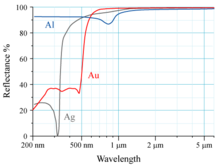Reflectance

The degree of reflection (also reflectivity , reflectivity or reflectance ) ρ (also R ) is the ratio between reflected and incident intensity as an energy variable , e.g. B. with electromagnetic waves ( luminous flux ) or with sound waves ( sound pressure , sound field size ). It is a question of a disturbed propagation of the wave.
- : reflected performance
- : incident power
In general, this also means the scattered reflection of a variable, for example the diffuse reflection of light on rough (“non-reflective”) surfaces. In astronomy and geography the term albedo is used for the diffusely reflected light flux.
Relationships with other physical quantities
When a wave is reflected, there is always a loss of energy from the reflected wave compared to the incident wave in the form of absorption and transmission. The following generally applies to the respective energy quantities:
in which
- the degree of absorption a measure of the absorbed,
- the transmittance is a measure of the transmitted,
- the degree of dissipation is a measure of the "lost" intensity.
For electromagnetic waves, in the case of directional reflection, the degree of reflection and the degree of transmission can be calculated using the Fresnel equations with the refractive indices of the materials involved.
In contrast to the degree of reflection , the reflection factor (also: reflection coefficient) relates to the amplitude of a variable. The reflectance corresponds to the square of the reflection factor :
For complex quantities, such as those that occur when light is reflected by absorbing media, the degree of reflection corresponds to the product of the reflection factor with its conjugate complex value :
Reflectivity in remote earth sensing
The graph on the right shows the degrees of reflection from 6 surfaces. The spectra were measured with a hyperspectral remote sensing sensor.
The figure above shows three vegetation spectra. These each have similar courses, but differ in their albedo . In the visible range of the spectrum (0.38 to 0.78 µm) the so-called green peak can be seen, which is generated by the strong light absorption of chlorophyll in the blue and red spectral range and the weaker absorption in the green range (around 0.55 µm) becomes. The green peak makes vegetation appear green to the human eye. The sharp increase in reflection by 0.7 µm is known as the red edge . The high reflection in the near-infrared spectral range (up to 1.3 µm) is caused by multiple scattering on the leaf structure, with no absorbing substances in this spectral range. Weak water absorption bands can be seen around 0.95 and 1.2 µm. The mid-infrared spectral range (1.3 to 2.5 µm) is dominated by strong water absorption bands around 1.45, 1.95 and 2.6 µm.
The figure below shows the reflection of the soil with straw, of grain just before harvest, and of cloudy water.
Others
The material with the lowest degree of reflection for visible light to date (0.045%) consists of a kind of mat with vertically arranged nanotubes made of carbon and was developed at the Rensselaer Polytechnic Institute . The thickness of the mat is between 10 and 800 micrometers .
See also
Individual evidence
- ↑ Zu-Po Yang, Lijie Ci, James A. Bur, Shawn-Yu Lin, Pulickel M. Ajayan: Experimental Observation of an Extremely Dark Material Made By a Low-Density Nanotube Array . In: Nano Letters . tape 8 , no. 2 , 2008, p. 446-451 , doi : 10.1021 / nl072369t .
















